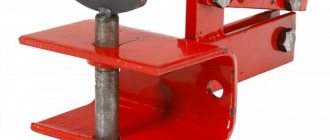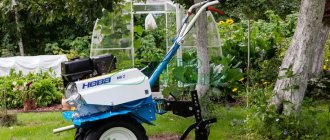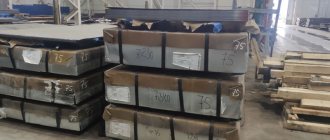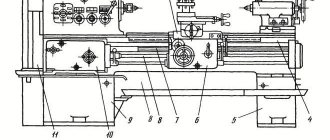Plow diagram
The plow diagram shows: (1) skimmer, (2) body, (3) harrow trailer, (4) frame, (5) disc blade, (6) tillage depth regulator, (7) support wheel, (8) hitch .
A hydropneumatic safety device is often used in plows. This part of the plow is needed in order to safely plow old arable soil clogged with stones and tree roots, which may partially protrude above the surface of the ground or be completely hidden in the ground soil. The main parts of the fuse are: a hydraulic cylinder, a pneumatic accumulator with a fitting and a piston, oil lines, a pressure gauge and a tap.
Read also: Toyota body color codes (Table)
Blade
The plow moldboard cuts off the soil layer from the wall of the furrow, turns it over and dumps the layer to the bottom of the formed furrow. The front of the blade is its chest, and the back is the wing. The chest wears out more intensively, so plows that are used for plowing heavy soils have a removable chest. The wing is subject to a constant bending moment, which can cause its deformation and subsequent failure.
The moldboard and ploughshare are attached to the plow stand with bolts with a countersunk head that does not protrude above the surface. When attaching, it is important that the blade fits tightly to the ploughshare along their joint line and does not protrude above the surface of the ploughshare.
General structure (diagram) of a plowshare plow
The arable unit consists of auxiliary elements and working parts mounted on a common frame. Auxiliary elements are designed to facilitate the work. They include support wheels (one or two), furrow wheels (for semi-mounted and trailed plows), a tillage depth adjustment mechanism, a trailing device or a hitch mechanism. The working parts include a knife, a skimmer with a subsoiler and the main body.
Working bodies
The knife is used to cut a vertical layer of soil, facilitating the entry of the body into the ground. It helps level the sulcus wall. General-purpose arable units are equipped with disc-type knives. Special plows used for cultivating heavy soils are equipped with handle-type knives.
The main body of the plow is designed to remove the soil layer, crumble it, wrap it and lay it on the bottom of the furrow. Its device includes a ploughshare, a blade and a field board mounted on a stand. The ploughshare cuts the soil layer. Plows can be equipped with trapezoidal, chisel-shaped, cut-out, with a cheek or a retractable chisel. The blade wraps the cut layer and drops it to the bottom of the formed furrow. Based on the type of blade, the bodies are divided into:
- Cultural - for the main cultivation of old arable soils;
- Half-screw - for plowing soddy soils;
- Cut-out - for cultivating lands with a thin fertile horizon;
- With a retractable chisel - for processing heavy clay soils and loams;
- With a subsoil paw - for plowing and simultaneous loosening of the subsoil layer of chestnut and podzolic soils;
- Disc - for processing heavy, root-choked trees or waterlogged soils;
- Rotary (rotating) - for preparing soils for crops, the cultivation of which requires high quality processing.
- Combined - for plowing with intensive grinding of the cultivated soil layer;
- Non-mouldboard - for preparing for sowing lands destroyed by wind erosion in arid regions. Plows with such a moldboard are called chisel plows.
The field board ensures the evenness of the plow body, preventing it from turning under the reaction of the soil. The body stand can be low (for processing heavy, abandoned soils) and high (for soft, cultivated soils). They are made by stamping. Each rack has a special saddle for attaching the housing.
The skimmer is designed to cut and crush the top layer of soil. It is designed similarly to the main body, but is smaller in size. Its working width is one third less than that of the main body.
Auxiliary parts
Depending on the type of connection between the arable unit and the tractor, the auxiliary parts have a number of distinctive features.
- A mounted plow has a frame welded from transverse, longitudinal and main hollow beams. Its device includes one support wheel equipped with a screw adjustment mechanism. The cross beam is equipped with an SA-2 automatic coupler, through which the arable unit is mounted on the tractor.
- The frame of semi-mounted plows consists of hinged hollow beams. Their equipment includes two support wheels, a transport mechanism with a pair of pneumatic wheels (field and furrow) and an automatic coupler.
- The design of trailed plows includes a device for connecting to a tractor and three pneumatic wheels: a furrow wheel, located in the area of the first body; field, located in the middle part of the plow and rear.
Connection to tractor
To attach a trailed plow, the tractor has a special linkage to which the coupling device of the plowing unit is attached. Mounted and semi-mounted arable units are connected to the tractor via an automatic coupler, consisting of a frame and a lock. The lock, made of two channels inclined at an angle of 65° to each other, is securely fixed with a bolt on a brace welded to the plow frame. The frame is fixed with a pin to the lower arms of the tractor hitch mechanism and with the help of a cheek to the upper link. The lock and frame are supported by a special pawl connected to the cabin by a cable. This allows you to unhook the plow without leaving the cab. The connection of mounted plows to the tractor is usually carried out using a two-point connection. Semi-mounted, wide-cut multi-furrow plows are mounted using a three-point system.
Features of special-purpose plows
Special-purpose plows are equipped with working bodies of a special design, allowing soil cultivation under specific conditions.
- Shrub-marsh plow PBN-75/PBN-100A. Its device includes one housing with a working width of 75 or 100 cm, disk; flat, equipped with a support ski, or a cutting knife, a linkage mechanism and a support wheel. Used for plowing drained mineral soils and peatlands, previously cleared of small shrubs from pastures and meadows.
- Reinforced plows for preparing for sowing rocky soils. They are equipped with automatic (PKU-4-35) or hydropneumatic (PGP-7-40, PKG-5-40) fuses. When hitting a tree root or stone remaining in the ground, the fuse is triggered and the body is pulled out of the soil. Having passed it, under the influence of the traction force of the tractor, the body is again buried in the ground.
- Longline plows PTN-40 and PTN-3-40. They are used when necessary to increase the depth of the subsoil horizon when cultivating depleted soils (podzolic and solonetzic), as well as to prepare land for planting garden trees, vineyards and cotton. In three-tier plowing, the first body cuts the top layer and dumps it to the bottom. The second body lifts the lower layer along with the upper layer laid on it, but does not wrap it around, but moves it to the side, forming a furrow. The second layer of soil removed by the rear body is dumped onto it. Double-tier plowing can be done in two ways. In the first case, the top layer falls onto the surface of the plowed area, and the bottom and middle layers are loosened and mixed. In the second case, the middle and lower horizons are brought to the surface, and the upper one is buried at a given depth.
- Single body plow. Used for cultivating light fertile soils in garden plots.
Varieties
The following types of such units can be distinguished:
- Rotary;
- Chisel;
- Ploughshares;
- Disk;
- Combined.
The most common are plowshare plows. This type was used by our ancestors, but even now they can also be found in the fields in working condition. Disc plows are used to plow heavy soil or dry soil. The combined and rotational type is used on complex devices that are used for cultivating virgin soil. The chisel type of tool does not provide for formation turnover. This type is classified as a plow conditionally and is very rarely used in agriculture.
According to the type of traction, the entire tool can be divided into the following categories:
- Tractor. This is the most convenient and common type. Such tools are produced for different models, so they are perfect for both a regular tractor and a mini-tractor or walk-behind tractor;
- For horse traction. This type is now very rare. Often they are used to cultivate those areas of land where a tractor cannot pass;
- On a cable car. This variety is used only in places where neither a tractor nor a horse can pass. Often this is a marshy area or a large slope.
Plows are available for both general and special purposes. Special purpose tools are divided into the following subgroups:
- For processing rocky soils. Such instruments have a special protective mechanism that protects the instrument from large stones;
- Negotiable. Their main feature is the presence of two identical plows, which are placed in a mirror image. Thanks to this technology, it is possible to perform smooth plowing, that is, to create a flat surface, without large embankments and furrows;
- Longline. Used to increase soil fertility.
Blueprints
When planning to make a plow with your own hands, you need to have some kind of role model. If you have an old plow, you can make new ones in its likeness. And if this is not the case, drawings will come in handy. Just take into account the parameters of your equipment on which you will hang it.
General purpose plow for tractor (single-body)
Detailing of some sizes.
Assembly drawing of a single-body plow
Plow drawing with dimensions
How to make a horse plow
- 1 DIY plow
- 2 What does a plow consist of?
- 3 Tests of a homemade plow
- 4 How the plow works
- 5 Conclusion
How to make a horse-drawn plow with your own hands will be of interest to anyone who is looking for an adequate option and instructions. Many have tried to make a plow in the likeness of a real horse or tractor plow. But usually such attempts ended in failure. A negative result is not a lack of will and patience, but a lack of skills and knowledge in the field of product geometry.
Manufacturers
On the agricultural machinery market you can find many different types of tractors and plows. Manufacturers such as Caliber and Dongfeng create tools for mini-tractors.
Dongfeng tools are distinguished by their strong mounts. The working mechanism produces neat dumps. The cost of such a unit from official representatives of the company can vary from 30 to 40 thousand rubles.
The Caliber company is a domestic production company that produces tools with a disk base. Their main feature is that the mass of the working unit is small, and due to this, a less powerful traction force is needed. The price of units from this manufacturer can range from 20-27 thousand rubles.
Step-by-step instruction
To make your own plow, it is recommended to adhere to a certain algorithm and choose certain materials. It is advisable to make the ploughshare from steel 9ХС or 45, but the use of carbon steel is also acceptable - in this case, the cutting part of the part is beaten on an anvil and sharpened before work. The ploughshare should be made removable - this simplifies the process of operating the tool.
Plow parts drawing
The dump can be made in two ways:
- Made from a durable tube with a diameter of 600 mm and walls of 5 mm. To do this, make a cardboard template of the part, lay it on steel, outline it with chalk and cut out the part. After cutting, it is processed with sandpaper and a hammer to the desired shape.
- If you have specialized sheet-bending equipment, the process of manufacturing a blade takes a minimum of time - a steel blank 4 mm thick is fed to the rollers at an angle of 23 degrees, bent and brought to the desired shape with a hammer.











